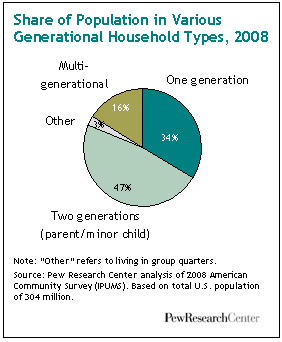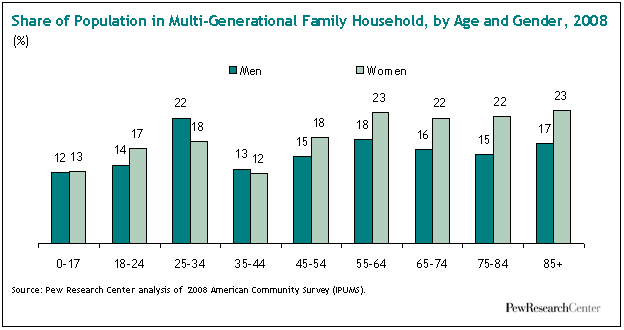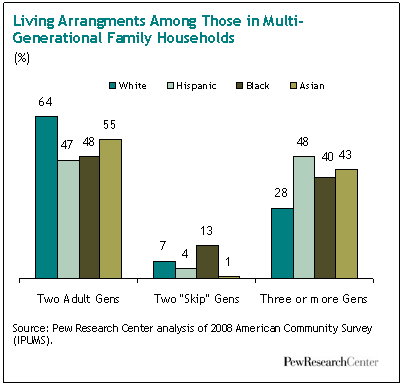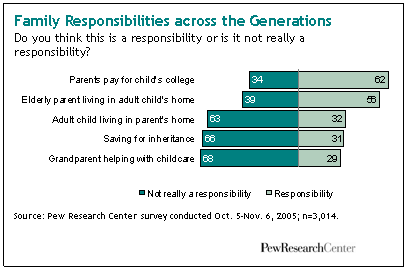Section I

The multi-generational American family household is staging a comeback — driven in part by the job losses and home foreclosures of recent years but more so by demographic changes that have been gathering steam for decades.
As of 2008, a record 49 million Americans, or 16.1% of the total U.S. population, lived in a family household that contained at least two adult generations or a grandparent and at least one other generation, according to a new Pew Research Center analysis of census data.1
This represents a significant trend reversal. Starting right after World War II, the extended family household fell out of favor with the American public. In 1940, about a quarter of the population lived in one; by 1980, just 12% did. A range of demographic factors likely contributed to this decline, among them the rapid growth of the nuclear-family-centered suburbs; the decline in the share of immigrants in the population; and the sharp rise in the health and economic well-being of adults ages 65 and older.

Since bottoming out around 1980, however, the multi-generational family household has mounted a comeback. The reversal has taken place among all major demographic groups, and it, too, appears to be the result of a mix of social and economic forces.
One is the change in the median age of first marriage. The typical man now marries for the first time at age 28 and the typical women at age 26. For both genders, this is about five years older than it was in 1970. One byproduct of this cultural shift is that there are more unmarried 20-somethings in the population, many of whom consider their childhood home to be an attractive living situation, especially when a bad economy makes it difficult for them to find jobs or launch careers.2

Another factor has been the big wave of immigration, dominated by Latin Americans and Asians, that began around 1970. Like their European counterparts from earlier centuries, these modern immigrants are far more inclined than native-born Americans to live in multi-generational family households.3
However, the trend reversal has also played out among native-born Americans. And for all groups, the move into multi-generational family households has accelerated during the Great Recession that began at the end of 2007. The Pew Research analysis of census data finds that in 20084, 2.6 million more Americans were living in such a household than had been doing so in 2007.
Who lives in multi-generational households? While the phenomenon has grown more prevalent in recent years among virtually all major demographic groups, the incidence levels vary considerably by age, race, ethnicity and gender. A rundown:
Older Adults

Older adults were once by far the likeliest of any age group to live in a multi-generational family household. Back in 1900, fully 57% of adults ages 65 and older did so. But over the course of the 20th century, older adults grew steadily healthier and more prosperous as a result of a range of factors, including the enactment of social safety net programs such as Social Security and Medicare and improvements in medical care.
With these changes came what amounted to a new intergenerational social contract within most families — namely, that older adults who had the health and resources to live independently should do so. By 1980 and 1990, just 17% of those ages 65 and older lived in a multi-generational family household. Since then, however, the trend has reversed course and the share has risen slightly — to 20%.
One possible explanation for the recent trend reversal is an increase in what demographers refer to as “kin availability.” The outsized Baby Boom generation is now passing through late middle age. Compared with earlier generations, it offers its elderly parents about 50% more grown children with whom they can share a household if and when their life circumstances (such as widowhood, declining health or poverty) take them in that direction. Another possible explanation is that cuts to Medicare enacted in 1997 have increased the financial incentives for those who are elderly and infirm to move in with a grown child who is able to take on the role of informal caregiver.5
When two adult generations of the same family live under the same roof, the older adult is the head of the household in about three-quarters of all cases, according to the Pew Research analysis of Census data. However, when the parent is 65 or older, the share drops. In 2008, a total of 6.6 million older adults lived in a household with one or more children. Of this group, 58% were themselves the household head, while in 42% of the cases, their grown child was the household head.

Young Adults
Older adults are not the age group most responsible for the overall trend reversal since 1980. That distinction belongs instead to young adults — especially those ages 25 to 34. In 1980, just 11% of adults in this age group lived in a multi-generational family household. By 2008, 20% did. Among adults 65 and older, the same share — 20% — lived in such a household in 2008. However, the rise for this group has been less steep. Back in 1980, 17% lived in a multi-generational family household.
As noted above, the trend toward older median ages for first marriage is a big part of this long-term shift among younger adults. But in recent years, the economy appears to have played a significant role. Just from 2007 to 2008, the share of adults ages 25 to 34 living in such households rose by a full percentage point, from 18.7% to 19.8%.
According to a recent Pew Research Center analysis of Bureau of Labor Statistics data, as of 2009 some 37% of 18- to-29-year-olds were either unemployed or out of the workforce, the highest share among this age group in nearly four decades. In addition, a 2009 Pew Research survey found that among 22- to 29-years-olds, one-in-eight say that, because of the recession, they have boomeranged back to live with their parents after being on their own.6
Gender
The increase in the share of young adults living with their parents is notable for another reason: its gender profile. The 25-34 age group is the only one in which significantly more men than women are living in a multi-generational family household. Among older age groups, this living arrangement is much more common among women than men. At the later stages of the life cycle, this disparity is partly explained by the fact that women are more likely than men to outlive a spouse, at which point they become more likely candidates to live with a grown child.

Race and Ethnicity
Hispanics (22%), blacks (23%) and Asians (25%) are all significantly more likely than whites (13%) to live in a multi-generational family household.
The rates of three of these four groups have increased significantly since 1980, with blacks the lone exce ption. However, the rates of all four groups have gone up from 2006 to 2008 — a time when the recession brought on a wave of joblessness and foreclosures.
Types of Multi-Generational Family Households
Of the 49 million Americans living in a multi-generational family household, 47% live in a household made up of two adult generations of the same family (with the youngest adult at least 25 years of age); another 47% live in a household with three or more generations of family members; and 6% are in a “skipped” generation household made up of a grandparent and grandchild, but no parent.

There are significant differences by race and ethnicity in the makeup of these various types of multi-generational family households.
Among whites living in a multi-generational family household, 64% are in a two adult-generation household, 28% are in a three-generation household and 7% are in a skipped- generation household.
Among Latinos, 48% are in a three-generation household, 47% are in a two-generation household and 4% are in a skipped-generation household.
Among blacks, 48% are in a two-generation household, 40% are in a three-generation household and 13% (the highest share for this category) are in a skipped-generation household.
Among Asians, 55% are in a two-generation household, 43% are in a three-generation household and just 1% are in a skipped-generation household.

Living Alone
The multi-generational household isn’t the only growth sector in the national landscape of living arrangements. There’s also been a steady long-term rise over the past century in the polar opposite kind of household — the one made up of just a single person. In 1900, just 1.1% of Americans lived in such a household. By 2008, that share had risen to 10.3%.
Here, too, there are significant variances by age. Among young adults (ages 18 to 24), just 4.6% live in such households, down from a peak of 5.7% in 1980. Among adults ages 65 and older, the numbers are much larger but they have declined from a recent peak. In 1900, just 5.9% of adults in this age category lived alone. That share rose steadily over the course of the last century, eventually peaking at 28.8% in 1990. Since then it has retreated a bit. As of 2008, it stood at 27.4%.

According to a Pew Research Center survey conducted last year, adults ages 65 and older who live alone report they are not in as good health and are more likely to feel sad, depressed or lonely than are older adults who live with another person (be it a spouse or some other family member). Chapters 2 and 3 of this report will explore those findings in greater detail.
Also, a separate Pew Research survey taken in 2005 found that a majority of the public (56%) considers it a “family responsibility” for adult children to take into their home an elderly parent who wants to live with them. A sizable minority — 39% — said this isn’t really a family responsibility. Attitudes varied sharply by the age of the respondent. Two-thirds of adults ages 40 and under said it was a family responsibility, compared with just 38% of adults ages 60 and over.7
About the Data
Data used in the report come from two complementary sources: First, the trends on Americans’ living arrangements come from Decennial Census data from 1900 to 2000 and the U.S. Census Bureau American Community Surveys (ACS) in 2006, 2007 and 2008, provided by the Integrated Public-Use Microdata Series (IPUMS). See Appendix A for more detailed information. Second, we use a recent Pew Research Center survey on aging, which provides information about attitudes and life of older Americans.
Survey results for this report are from a telephone survey conducted with a nationally representative sample of 2,969 adults living in the continental United States. A combination of landline and cellular random digit dial (RDD) samples were used to cover all adults in the continental United States who have access to either a landline or cellular telephone. In addition, oversamples of adults 65 and older as well as blacks and Hispanics were obtained. A total of 2,417 interviews were completed with respondents contacted by landline telephone and 552 from those contacted on their cellular phone. The data are weighted to produce a final sample that is representative of the general population of adults in the continental United States.
- Interviews were conducted Feb. 23-March 23, 2009.
- There were 2,969 interviews, including 1,332 with respondents 65 or older.
- The margin of sampling error is plus or minus 2.6 percentage points for results based on the total sample at the 95% confidence level.
- Survey interviews were conducted under the direction of Princeton Survey Research Associates International.
About the Report
This report is organized into three chapters. Chapter 1 explores the recent rise in multi-generational family households. Chapter 2 describes changes over time in the living arrangements of older adults. Chapter 3 explores the differences in experiences and attitudes between older adults who live alone and those who live with others.
Note on terminology: All race groups include only non-Hispanics; e.g., whites include only non-Hispanic whites, blacks include only non-Hispanic blacks. Hispanics are of any race. Asians include Pacific Islanders.
Terminology
Here are descriptions of the household types analyzed in this report:
One-generation household Households that consist of only one generation; for example, a married or cohabiting couple, a single person, siblings or roommates. These households can be made up of families or non-families.
Two-generation family household Households that include a parent or parents and their child or children under age 25 (including stepchildren).
Multi-generational family household The following family households are included in this category:
- Two generations: parents (or in-laws) and adult children ages 25 and older (or children-in-law); either generation can “head” the household
- Three generations: parents (or in-laws), adult children (and spouse or children-in- law), grandchildren
- “Skipped” generation: grandparents and grandchildren, without parents (including step-generation)
Read the full report for more details.




